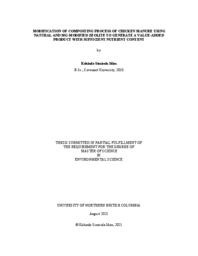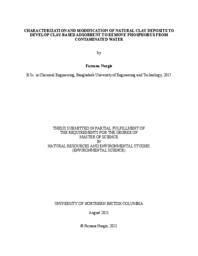University of Northern British Columbia. NRES-Environmental Science
Related Works
Content type
Digital Document
Description / Synopsis
This research was aimed at developing a composting process of organic waste using natural and modified zeolites by ascertaining how effective they were in retaining phosphorus (P) after 60 days. The experiments included compost (C) containing natural (N) and modified (M) zeolite (Z) treatments (applied at 10% and 15% on a weight basis of the total waste): CNZ10, CNZ15, CMZ10, CMZ15 and C (which is the control treatment with no zeolite addition). The second objective was to compare the barley shoot biomass and nutrient concentration of the various compost treatments mixed with soil and control treatment (just soil) after 45 days of planting in the greenhouse. In general, the benefits of co-addition of compost and zeolite on sandy soil were tested in a completely randomized experimental design. The results indicated that the treatments with the highest zeolite treatments (CNZ15 and CMZ15) proved most effective at retaining P by the end of the composting process (2.8mg and 2.9mg respectively) compared to the lower zeolite ratios and the control treatment; CNZ10 (2.0mg), CMZ10 (1.9mg) and C (0.7mg). The barley shoot biomass results indicated that the treatments that had a combination of soil (S) and modified zeolite (SCMZ10 and SCMZ15) had biomass of 7.67g and 7.24g respectively, followed by the natural zeolite and compost treatments (SCNZ10, SCNZ15 and SC) having 6.19g, 6.38g and 5.99g respectively and were significantly different from the control treatment (S) which had the lowest biomass of 0.48g. With respect to the plant nutrient concentration, N and P were significantly higher in the control treatment (S) compared to the other treatments while K concentration was significantly highest in the compost and some of the zeolite treatments (SC, SCNZ15 and SCMZ15) compared to other treatments. These results were in line with some previous findings where zeolite was used as a soil amendment in agriculture.
Origin Information
Content type
Digital Document
Description / Synopsis
Modification of natural clays may be a useful approach to produce an effective and low-cost adsorbent to control phosphorous, which is a key factor in controlling the eutrophication of surface waters. In this study, natural clay samples were collected, characterized, modified with ZrCl4, and then their adsorption capacity for removing phosphorus from contaminated water was studied. XRD analysis showed that the natural clay consists of kaolinite, illite, and nontronite as dominant clay mineral phases. The maximum adsorption capacity of the modified clay increased from 0.493 to 11.83 mg P/g compared to the unmodified clay. The adsorption process was fast for both natural and modified samples, achieving more than 80% and 90% phosphorus removal with natural and modified samples, respectively in less than 4 hours. The adsorption data for both clays best fit the Langmuir isotherm, and the rate of phosphorus adsorption was found to follow a pseudo-secondorder kinetic model. The adsorption capacity of both adsorbents decreased with increasing pH, and for the modified clay the change was more significant. Full factorial design and response surface methodology were applied to evaluate and optimize the effects of initial P concentration, contact time, pH, and dose. From the model, the maximum P removal efficiency predicted for the synthetic solution was 91.5% and 99.9% by natural and modified clay, respectively. R2(≈0.98) indicates that the observed results fitted well with the model prediction. Similar to the batch studies, the fixed bed column study showed the developed adsorbents are efficient in removing phosphorus from water in a continuous process as well.
Origin Information


